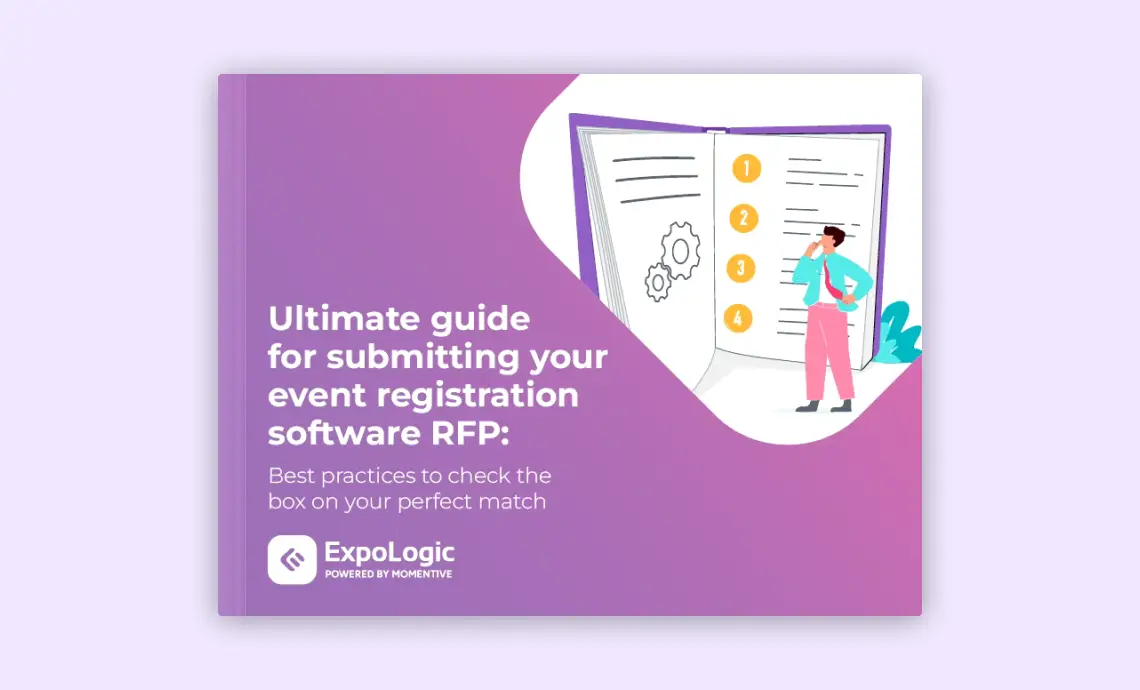Navigating the event planning landscape can be complex, especially when it comes to finding the right partners to bring your vision to life. A well-crafted Request for Proposal (RFP) is a powerful tool that can streamline this process, helping you articulate your needs and evaluate potential vendors with precision.
Demystifying the RFP Process
Whether you’re new to drafting RFPs or looking to refine your approach, this guide will equip you with the knowledge to create effective RFPs and secure the ideal partners for your events.
An RFP in event management is a formal document used by organizations to solicit proposals from potential vendors or service providers for an upcoming event. It outlines the organization’s needs, goals, and requirements for the event and invites vendors to submit detailed proposals on how they can meet these needs. The RFP process helps compare and assess vendor capabilities to choose the most suitable partner for the event.
Key Components of an Effective Event Management RFP
It is essential to clearly communicate your event management needs to potential vendors. It helps to gather tailored proposals and facilitates a more efficient and transparent selection process, ultimately leading to a more successful event.
A well-structured RFP evokes:
- Clarity and Precision: It provides clear guidelines and expectations, reducing misunderstandings and ensuring vendors align their proposals with your needs.
- Competitive Bidding: By detailing your requirements, you create a competitive environment where vendors can present their best solutions, often resulting in a better value for your investment.
- Efficient Evaluation: A well-organized RFP facilitates a more straightforward evaluation process by making it easier to compare proposals.
- Risk Mitigation: By clearly defining your needs and expectations, you minimize the risk of selecting a vendor that may not meet your requirements or deliver on promises.
An effective event management RFP includes essential components that ensure your requirements are clearly defined and easily understood by potential vendors. Key elements such as detailed event goals, specific feature needs, and evaluation criteria will ensure that you receive accurate and relevant proposals that align with your event objectives.
An effective RFP should include the following components:
- Event Overview: A summary of the event, including its purpose, format (in-person, virtual, or hybrid), and key objectives.
- Scope of Work: Detailed description of the services required, such as venue management, catering, audiovisual needs, and any additional elements like entertainment or special guest arrangements.
- Timeline: Key dates for the event, including deadlines for proposal submission, vendor selection, and the event date itself.
- Budget: An outline of the budget range or financial constraints to guide vendors in proposing solutions within your budget.
- Selection Criteria: The criteria by which proposals will be evaluated, such as experience, cost, creativity, and ability to meet deadlines.
- Submission Guidelines: Instructions on how to submit proposals, including format, deadline, and any additional documentation required.
Setting the Stage for a Successful Partnership
By carefully planning and detailing your event requirements, you can craft an RFP that attracts the right proposals and sets the stage for a successful partnership.
Initial Research and Planning
Understand your event’s needs, define your goals, and identify the specific services and solutions required. Research potential vendors and assess their capabilities to ensure they align with your event objectives.
Defining Your Company Event Needs and Goals
Clearly define what you hope to achieve with your event. Are you looking to enhance attendee engagement, streamline logistics, or maximize return on investment? Outline these goals in your RFP to guide vendors in proposing solutions that are relevant to your needs.
Creating a Detailed RFP Document
Draft a comprehensive RFP document that includes all the essential components mentioned earlier. Ensure that it is detailed, clear, and easy to understand. Use a professional tone and provide ample information to help vendors prepare well-informed proposals.
The 7 Steps to a Successful RFP
Crafting a successful RFP involves a series of strategic steps to ensure you create a comprehensive and practical document. These seven essential steps are your guide, from defining your objectives to finalizing agreements and providing a well-organized and efficient selection process.
Step 1: Define Your Objectives and Requirements. Identify and articulate your event’s goals and requirements. Be specific about what you need and expect from the vendor to ensure they can effectively meet your objectives.
Step 2: Identify Potential Vendors. Research and compile a list of potential vendors who have the experience and expertise relevant to your event. Consider vendors with a proven track record and positive references.
Step 3: Write a Clear and Concise RFP. Create an RFP document that is clear, detailed, and concise. Ensure it covers all aspects of the event and provides vendors with the necessary information to submit accurate and relevant proposals.
Step 4: Distribute the RFP to Potential Vendors. Send the RFP to your list of selected vendors. Ensure that you provide a clear deadline for submission and offer a designated point of contact for any questions or clarifications.
Step 5: Evaluate the Proposals Received. Evaluate each proposal’s ability to meet your needs, budget, and timeline, and consider factors such as creativity and vendor experience.
Step 6: Select the Most Suitable Vendor. Choose the vendor that best meets your requirements and offers the best value. Consider conducting interviews or follow-up discussions to finalize your decision.
Step 7: Finalize the Agreement and Begin Collaboration. Once you have selected a vendor, finalize the contract and begin working together. Ensure that all details are agreed upon and that both parties are clear on expectations and deliverables.
Best Practices for Event Management Proposals
Adhering to best practices for event management proposals ensures that your RFP process is both thorough and efficient. These practices, such as timeline clarity and realistic budgeting, help attract high-quality proposals and select the best vendors for your event.
Establish realistic deadlines for proposal submission, evaluation, and decision-making. Allow ample time for vendors to prepare comprehensive proposals and for you to review them thoroughly.
Provide a clear budget range and financial constraints. Transparent budgeting helps vendors propose solutions that fit within your financial limits and prevent unexpected costs.
Use a structured evaluation process to compare vendor proposals. Consider factors such as experience, cost, and alignment with your event goals to make an informed decision.
Tools and Templates for Streamlined RFP Creation
Utilizing tools and templates for RFP creation streamlines the process by providing structured formats and automated features to enhance efficiency. These resources help ensure consistency, save time, and simplify the creation of comprehensive and professional RFP documents.
Utilizing sample RFP templates as a starting point can provide a helpful structure and ensure you include all necessary components. Leverage online tools designed for RFP management to streamline the process. These tools can help with document distribution, proposal tracking, and communication with vendors. Make sure you tailor the RFP document and management tools to align with your event’s unique requirements and objectives.
Frequently Asked Questions
| What is an Event Management Proposal? | An event management proposal is a document submitted by vendors in response to an RFP. It outlines how they plan to address your event’s needs, including their approach, budget, and timeline. |
| How Can a RFP Improve Event Management? | An RFP improves event management by clarifying your needs, encouraging competitive bidding, and providing a structured way to evaluate vendor capabilities and costs. |
| What Key Components Should be Included in an RFP? | An effective RFP should include detailed information on event objectives, scope, budget, timelines, specific requirements, and evaluation criteria. This ensures vendors provide relevant and comprehensive proposals. |
| How Should I Evaluate Proposals Received from Vendors? | Evaluate proposals based on criteria such as alignment with your event needs, cost-effectiveness, vendor experience, and quality of proposed solutions. Consider how well each proposal addresses your objectives and the vendor’s ability to meet deadlines and provide support. |
| Can I Negotiate Terms with Vendors After Receiving Proposals? | Yes, negotiating terms with vendors is a common practice. Use the proposals as a basis for discussion to refine pricing, service levels, and other contract terms to ensure the final agreement meets your event’s needs and budget. |
| What are Some Tips for Negotiating with Vendors? | Be clear about your expectations, ask for detailed breakdowns of costs, and negotiate terms to ensure that both parties are satisfied with the agreement. |
| What are Some Common Pitfalls to Avoid in the RFP Process? | Avoid vague requirements, unrealistic timelines, and inadequate vendor research. Ensure that your RFP is detailed, realistic, and well-distributed to attract quality proposals. |
| What Tools and Templates Can Help with Creating an RFP? | Tools and templates designed for RFP creation can streamline the process by providing structured formats and pre-built sections. Online RFP management tools and customizable templates can help ensure consistency and efficiency in drafting your RFP. |





